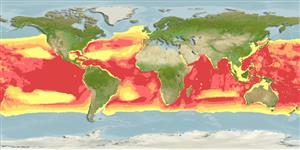Common names from other countries
Environment: milieu / climate zone / depth range / distribution range
Écologie
Pélagique; océanodrome (Ref. 75906); profondeur 0 - 3793 m (Ref. 94963), usually 500 - 1100 m (Ref. 80612). Tropical; 90°N - 90°S, 180°W - 180°E
Atlantic Ocean and Indo-Pacific.
Length at first maturity / Taille / Poids / Âge
Maturity: Lm ?, range 210 - 220 cm Max length : 270 cm TL mâle / non sexé; (Ref. 1394); poids max. publié: 210.0 kg (Ref. 1394)
Description synthétique
Morphologie
Robust. Short beak, subtriangular to weakly falcate dorsal fin, pointed flippers, and relatively small concave flukes. Dark bluish to brownish-gray dorsal cape, pale gray flank, and white to pinkish belly. Wide dark gray to black stripe extending from the eye to the anus, conspicuously set off by thin pale cream-colored borders.
Pantropical distribution. Dolphins are directly caught for use as shark-bait in Sta. Ana and Aparri, Philippines (Ref. 77119). Minimum depth from Ref. 116169. Often seen near shore, along the outer continental shelf and in deep oceanic waters (Ref. 80620). Feeds in deep waterse (Ref. 122680). Feeds on mid-water fish, squid and crustaceans (Ref. 1394). Forms large social groups (Ref. 122680). Occasionally sighted with melon-headed whales, Peponocephala electra. (Ref. 80612).
Life cycle and mating behavior
Maturité | Reproduction | Frai | Œufs | Fécondité | Larves
Does not show strong evidence of seasonality in calving (Ref. 80616).
Tan, J.M.L. 1995. (Ref. 936)
Statut dans la liste rouge de l'IUCN (Ref. 130435)
statut CITES (Ref. 108899)
Utilisations par l'homme
Pêcheries: commercial; appât: usually
FAO - pêcheries: species profile | FishSource | Sea Around Us
Outils
Sources Internet
Estimates based on models
Preferred temperature
(Ref.
115969): 1.5 - 3.8, mean 1.8 (based on 2563 cells).
Résilience
Haut, temps minimum de doublement de population inférieur à 15 mois (K=0.48; tm=8).
Vulnérabilité
Moderate vulnerability (42 of 100).
Catégorie de prix
Unknown.
